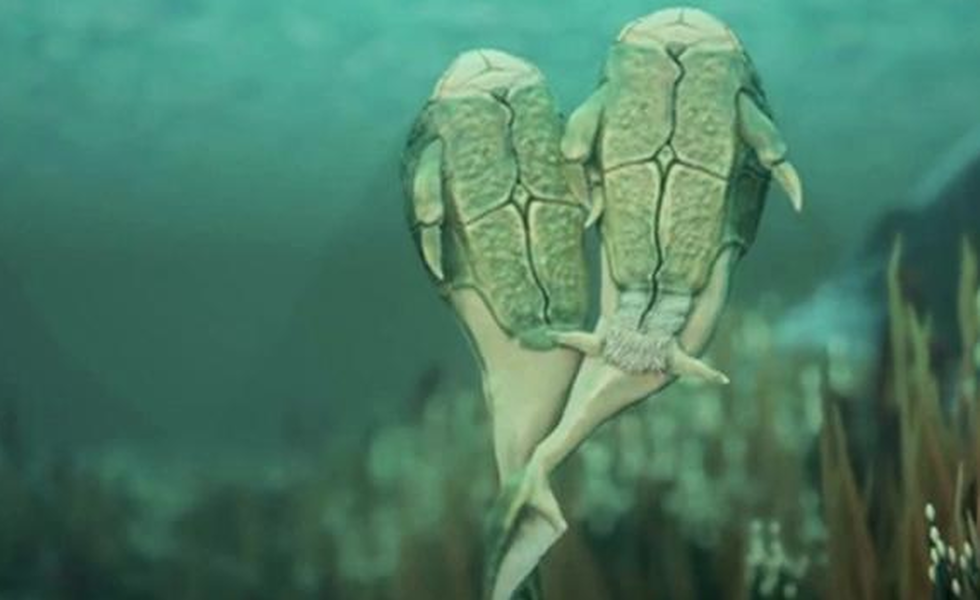Scientists discover the origins of sex — thanks to 'square-dancing fish'


New research from Flinders University in Australia has found that the first sexual intercourse occurred in ancient armored fish more than 385 million years ago.
A new study published Sunday in the journal Nature suggests that antiarch placoderms, fish that are among the first vertebrates with jaws, were the first animals to reproduce with internal fertilization. Their copulation methods "resembled square dancing," Discovery News reports.
Each male antiarch apparently had a bony, L-shaped clasper that "could have only reached the female's genital region if the fishes were lying side by side," study author John Long told Discovery News. The females' genitalia, meanwhile, included genital plates that helped lock the claspers into place.
The Week
Escape your echo chamber. Get the facts behind the news, plus analysis from multiple perspectives.

Sign up for The Week's Free Newsletters
From our morning news briefing to a weekly Good News Newsletter, get the best of The Week delivered directly to your inbox.
From our morning news briefing to a weekly Good News Newsletter, get the best of The Week delivered directly to your inbox.
"When you look at the shape of these structures, they can't possibly do anything in a missionary position," Long told the Sydney Morning Herald. "We've printed out 3D models of these fish, and I can play mating games with them, and the only way possible they can do it is sideways, square dance style, with their little arms entangled."
The scientists believe that the antiarchs were "the first animals to develop specific male and female genitalia, allowing them to have internal sex," the Sydney Morning Herald notes. The antiarch discovery proves that sexual intercourse began as many as 100 million years earlier than previously thought. Before fish had gender-specific organs, they would "shed their gametes in open water" to fertilize each other.
"This is not just about bony structures on these fish, it's about the evolution of behavior, of when sex first became fun," Long told the Sydney Morning Herald. "Why would something develop these big, bony clasper things and place them inside a female, unless they enjoyed the act?"
A free daily email with the biggest news stories of the day – and the best features from TheWeek.com
Meghan DeMaria is a staff writer at TheWeek.com. She has previously worked for USA Today and Marie Claire.
-
 The Week’s big New Year’s Day quiz 2026
The Week’s big New Year’s Day quiz 2026Quiz of the Year How much do you remember about 2025’s headlines? Put yourself to the test with our bumper quiz of the year
-
 Is tanking ruining sports?
Is tanking ruining sports?Today's Big Question The NBA and the NFL want teams to compete to win. What happens if they decide not to?
-
 ‘Netflix needs to not just swallow HBO but also emulate it’
‘Netflix needs to not just swallow HBO but also emulate it’instant opinion Opinion, comment and editorials of the day
-
 Blue Origin launches Mars probes in NASA debut
Blue Origin launches Mars probes in NASA debutSpeed Read The New Glenn rocket is carrying small twin spacecraft toward Mars as part of NASA’s Escapade mission
-
 Dinosaurs were thriving before asteroid, study finds
Dinosaurs were thriving before asteroid, study findsSpeed Read The dinosaurs would not have gone extinct if not for the asteroid
-
 SpaceX breaks Starship losing streak in 10th test
SpaceX breaks Starship losing streak in 10th testspeed read The Starship rocket's test flight was largely successful, deploying eight dummy satellites during its hour in space
-
 Rabbits with 'horns' sighted across Colorado
Rabbits with 'horns' sighted across Coloradospeed read These creatures are infected with the 'mostly harmless' Shope papilloma virus
-
 Lithium shows promise in Alzheimer's study
Lithium shows promise in Alzheimer's studySpeed Read Potential new treatments could use small amounts of the common metal
-
 Scientists discover cause of massive sea star die-off
Scientists discover cause of massive sea star die-offSpeed Read A bacteria related to cholera has been found responsible for the deaths of more than 5 billion sea stars
-
 'Thriving' ecosystem found 30,000 feet undersea
'Thriving' ecosystem found 30,000 feet underseaSpeed Read Researchers discovered communities of creatures living in frigid, pitch-black waters under high pressure
-
 New York plans first nuclear plant in 36 years
New York plans first nuclear plant in 36 yearsSpeed Read The plant, to be constructed somewhere in upstate New York, will produce enough energy to power a million homes
